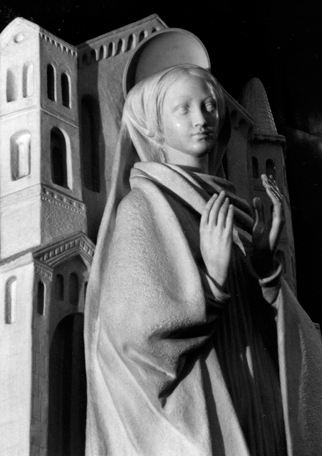Mother of the Church
Seeing Mary with New Eyes

Mary, Mother of the Church, has inspired many visitors to the SSND Generalate in Rome.
In 1964 when Pope Paul VI spoke of Mary as Mother of the Church, the General Council of the School Sisters of Notre Dame chose to dedicate the new generalate chapel in Rome to Mary under this title. October 11, 1966, was the dedication of the new Generalate Chapel on the feast of Mary Mother of the Church. Pope John Paul II gave the history of Mary’s role as Mother of the Church.1
Pope Paul VI would have liked the Second Vatican Council itself to have proclaimed “Mary Mother of the Church, that is, of the whole People of God, of the faithful and their Pastors.” He did so himself in his speech at the end of the Council’s third session (21 November 1964), also asking that “henceforth the Blessed Virgin be honored and invoked with this title by all the Christian people.” (AAS 1964, 37).
Later in 1974, Pope Paul VI wrote an encyclical entitled “Marialis Cultus” in which he encouraged the faithful to renew their love for Mary by developing devotions appropriate to the changing times and respectful of the ecumenical movement. “This shows the need for Episcopal conferences, local churches, religious families, and communities of the faithful to promote a genuine creative activity in proceeding to a careful revision of expressions and exercise of the piety directed toward the Blessed Virgin. We would like this revision to be respectful of sound tradition and open to the legitimate desires of today’s people.” #24
In working with those who designed the statue of Mary, Mother of the Church in the chapel of the SSND generalate, the sisters experience some of the tension involved in looking at Mary with different perspectives.
As Elizabeth Johnson summarizes: “This renewed Mariology should be biblical, (rooted in scripture) liturgical, (respecting Mary’s role especially in Advent and Pentecost) ecumenical, (be in harmony with agreements already in place among Protestant, Orthodox, and Catholics) anthropological (conscious of the changing role of women in society, especially as women take on leadership in society: an image of Mary as passive and subservient is not acceptable to many modern women) and theological (it would have God as the center – with Mary placed in relation to Christ and to the Church”2
Footnote:
- Pope John Paul II, L’Obsservatore Romano, Weekly Edition in English 24 September 1997, page 11.
- Catholic Update, “In Search of the Real Mary,” by Elizabeth Johnson, CSJ, (Cincinnati: St. Anthony Messenger Press, 2001).